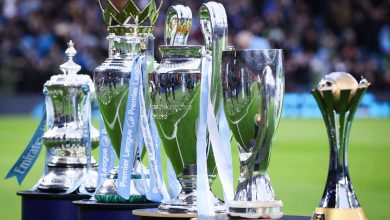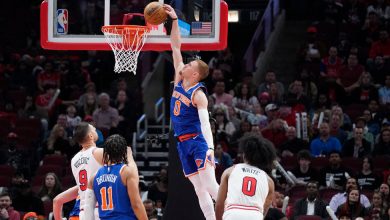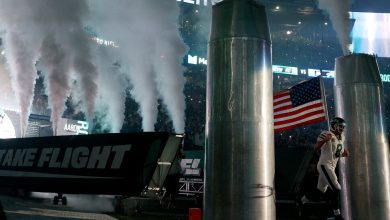When Will Federer and the Williams Sisters Call It Quits? Maybe Never.

WIMBLEDON, England — Most tennis professionals are retired by their mid-30s. But last week, there was Serena Williams, at almost 41, grinding against a competitor a little more than half her age for more than three hours at Wimbledon.
Venus Williams, too, is here. She played mixed doubles, with tape on her right knee and not so much spring in her step at age 42. Roger Federer, who has not played since limping away from Wimbledon last year, is angling to return to the tennis tour in September, when he will be freshly 41. Rafael Nadal is threatening a deep Wimbledon run and eyeing the Grand Slam at 36 after a medical procedure that deadened the nerves in his troublesome left foot.
To varying degrees, the biggest names in tennis keep going. Why is it so hard, with their best years behind them, to leave the stage and kick back with their millions? And it’s not just tennis. Tiger Woods, with an estimated net worth of $1 billion, is struggling to come back from devastating leg injuries at 46. Tom Brady can’t stay away from football. Regular working people go through life believing that retirement is the endgame. Not so with professional athletes.
It is not just advances in physical preparation and nutrition keeping their bodies in the game. The changing nature of sports business and celebrity is conspiring to keep stars at it far longer than they have in the past. But there is also another element that has remained constant across the generations.
“I get it 100 percent why they want to keep going,” said Martina Navratilova, a longtime No. 1 and 18-time major singles champion who retired at 37 in 1994, came back to play doubles and did not retire for good until she was almost 50.
“You really appreciate it, and you realize how lucky you are to be out there doing what we do,” Navratilova said. “It’s a drug. It’s a very legal drug that many people would like to have but they can’t get.”
Serena Williams exited Wimbledon in the first round for the second consecutive year, far from her fittest and gasping for air down the stretch. She and Federer soon face having no ranking in the sport they dominated for decades. Venus Williams decided at the last minute to play in mixed doubles at Wimbledon. But there have been no announcements on exit strategies; no target dates on end dates.
“You never know where I’ll pop up,” Venus Williams said Friday, before she and Jamie Murray lost on Sunday to Alicia Barnett and Jonny O’Mara in a third-set tiebreaker in the round of 16.
Earlier Sunday, at a ceremony at Centre Court, Federer, who has a men’s record eight Wimbledon titles but has not played a match in a year, said he hoped to play Wimbledon “one more time” before he retired.
It is a new sort of limbo: great champions well past their primes but not yet ready to call it a career while outsiders occupy themselves with speculation on when the call will come. Nadal, who has generated plenty of retirement chatter himself and said he was close to retiring only a couple of weeks ago because of chronic foot pain, understands the public’s quest for clarity. Famous athletes “become part of the life of so many people,” he said after advancing to the third round of Wimbledon.
Even Nadal said he felt unsettled after seeing his friend Woods become only a part-time golfer. “That’s a change in my life, too.”
But Woods, and the Williams sisters, like other aging and often-absent sports stars, remain active, not retired. There can be commercial incentives to keep it that way. Official retirement not only terminates a playing career. It can terminate an endorsement contract or a sponsorship deal and reduce a star’s visibility.
“Typically, it’s black and white that when you announce your retirement, that’s clearly giving the company a right to terminate,” said Tom Ross, a longtime American tennis agent.
But there are exceptions, Ross said, and champions who are late in their careers and of the stature of Federer and Serena Williams often have deals that provide them with security even if they retire before the deal expires. Federer’s 10-year clothing contract with Uniqlo is one example.
He, like Serena Williams, also has the luxury of time.
Nearly any other tennis player without a ranking would not be able to secure regular entry into top tournaments if they did decide to continue. But Federer and Williams have access to wild cards with their buzz-generating cachet, and can thus pick their spots.
Nike, as Federer and some others have discovered, is disinclined to commit major money to superstars close to retirement, favoring active athletes with longer runways. But Mike Nakajima, a former director of tennis at Nike, said that Williams, still sponsored by Nike, was in an exceptional position. She has her own building on Nike’s campus.
“Her building is bigger than the Portland International Airport,” Nakajima said. He added, “She’s had her hands in so many different things, so many interests, so many passions, that I think in a lot of ways it won’t matter when she stops. Serena will always be Serena.”
This week, EleVen by Venus Williams, her lifestyle brand, started a Wimbledon collection of all-white clothing that was not hurt by the fact that Williams was actually playing at Wimbledon, if only in mixed doubles, after more than 10 months away from the tour.
“Just inspired by Serena,” Venus Williams said.
Navratilova, like many in the game, believes that Venus and Serena Williams will retire together when the time comes. If it comes. The advantages of formally announcing retirement are few: a temporary surge in publicity and an end to random drug testing. It can, in some cases, start the clock on your pension or on making you eligible to be elected into a sport’s Hall of Fame.
Retirement is perhaps more a rite than a necessity. John McEnroe, for one, never officially retired, a technicality which, in his case, did allow him to keep earning more for a time from some existing contracts.
“Well, look how well retirement worked out for Tom Brady; it got a lot of attention and then it was, ‘Oh, I changed my mind.’ OK!” Navratilova said with a laugh. She added, “Do you ask a doctor or a lawyer how much longer are you going to keep practicing? People put thoughts in your head that might not be there otherwise.”
Federer has been hearing retirement questions since he finally won the French Open in 2009, completing his set of singles titles at each of the four Grand Slam events at age 27. Venus Williams, who went through a midcareer dip partially linked to an autoimmune disorder, has been hearing them for over a decade, as well.
“When it’s my last, I’ll let you know,” she said at Wimbledon last year.
Here she is, back for more, just like her kid sister, although perhaps even the Williamses don’t know how much more. Navratilova does not recommend giving too much advance notice. When she announced that 1994 would be her last season, she regretted it.
“If I had to do it over again, I would definitely not say anything, because it was exhausting; it was much more emotionally draining than it would have been otherwise,” she said. “For your own good, forget whatever it may do for or against your brand. I wouldn’t announce it until that’s it.”
And it was not it. She came back and ended up winning the U.S. Open mixed doubles title with Bob Bryan in her real last tour-level match at age 49, one of tennis’s better final acts.
“My thing is, if you enjoy playing and really get something out of it still, then play,” Navratilova said. “Venus has been playing and people say she’s hurting her legacy. No, those titles are still there.”




